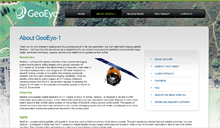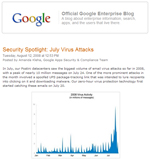Archive for the ‘Google’ Category
Posted by //
Sean
Date //
Sep 10, 08 - 7:26 am
Categories //
Geekery
Google
Technology
Videos
Comments Off on Google, REM And The Large Hadron Collider (LHC)
So today was the big day for the Large Hadron Collider to fire up and possibly create black holes that would gobble up the Earth and Google celebrated with a light speed inspired Google logo:
Here’s a little nugget about the LHC:
The Large Hadron Collider (LHC) is being built in a circular tunnel 27 km in circumference. The tunnel is buried around 50 to 175 m. underground. It straddles the Swiss and French borders on the outskirts of Geneva.
It planned to circulate the first beams 10th September 2008. First collisions at high energy are expected about a month later with the first results from the experiments soon after.
The LHC is designed to collide two counter rotating beams of protons or heavy ions. Proton-proton collisions are foreseen at an energy of 7 TeV per beam.
If you want to find out more about the Large Hadron Collider, check out the official website which is loaded with all sorts of geektastic information to make your head spin.
To quote the band R.E.M. from the video below, did you think it was “the end of the world as we know it?”:
I don’t know about you, but I was slightly worried about the Earth being sucked into a black hole. I know, such a nice thought as I was getting ready for bed last night.
Posted by //
Sean
Date //
Sep 8, 08 - 9:02 am
Categories //
Geekery
Google
Technology
Comments Off on Google Launches Mapping Satellite
 Google has expanded its reach into space with the successful launch Saturday of a new satellite that will provide the company with exclusive images for its maps.
Google has expanded its reach into space with the successful launch Saturday of a new satellite that will provide the company with exclusive images for its maps.
After an 11:50 a.m. takeoff from Vandenberg Air Force Base in California, the GeoEye-1 satellite relayed a downlink signal to a ground station in Norway, confirming that it had separated from its United Launch Alliance Delta II rocket and had begun to initialize its onboard systems.
The satellite launch was coordinated by terrain mapping company GeoEye. “Based upon the data we saw, the satellite is performing properly and ready to begin the next phase towards meeting its mission requirements,” said Bill Schuster, GeoEye chief operating officer, in a statement.
GeoEye said the 4,310-pound satellite required calibration and check-out period before the company would sell its images.
Although GeoEye did not mention Google in any of its announcements regarding the satellite, the search engine giant’s name appeared on the satellite and company founders Sergey Brin and Larry Page attended the launch, according to reports.
GeoEye said it plans to sell the images to customers around the world, but a Google spokesperson said that Google has exclusive rights to the images for commercial maps.
“The imagery from GeoEye-1 adds to the quantity and quality of that currently provided by our IKONOS satellite, and together this magnificent constellation will enable us to meet world-wide customer demand,” Matthew O’Connell, GeoEye CEO, said.
GeoEye-1 is part of the National Geospatial-Intelligence Agency (NGA), NextView program, which aims to obtain timely and accurate commercial satellite imagery.
It will collect 0.41-meter ground resolution black and white images and 1.65-meter color images simultaneously. It can show objects as small as 16 inches. U.S. licensing restrictions limit commercial images to a half-meter ground resolution.
The satellite can capture the images from 423 miles above the Earth and travel about 4.5 miles per second.
General Dynamics Advanced Information Systems in Gilbert, Ariz., built the satellite, while ITT in Rochester, N.Y., developed the imaging system. ITT is building another imaging system for GeoEye-2, which is scheduled to launch in 2011.
GeoEye said it won a $500 million NextView contract four years ago, and it built and launched the satellite with no cost overruns.
Source: GeoEye-1 Launch Site
Posted by //
Sean
Date //
Sep 1, 08 - 12:58 pm
Categories //
Google
Open Source
Software
Technology
Comments Off on Google Is Polishing Off Chrome: New Web Browser
 Yes, you read that correctly. Google is taking a major swipe at its competitors with the imminent launch of Chrome, a new Web browser based on Webkit, thus marks the beginning of a new phase in the browser wars.
Yes, you read that correctly. Google is taking a major swipe at its competitors with the imminent launch of Chrome, a new Web browser based on Webkit, thus marks the beginning of a new phase in the browser wars.
Kara Swisher at All Things Digital got perhaps one of the biggest scoops of the year. She spoke to some people familiar with some of the projects Google is working on.
Those sources say that Google is set to unveil a brand new Web browser that will be available to everyone as early as tomorrow (Tuesday).
Not only is Google going announcing a new browser, but it is making the announcement with a comic book. That’s hot.
Google has talked the browser talk for years. The last time I heard anything formal about it from the Google camp was nearly a year ago. Looks like Google is ready to walk the browser walk with Chrome.
Here are some details about what makes Chrome so great, as relayed by Blogoscoped.
Chrome is an open source browse based on Webkit. It will include aspects of Google’s Gears. It will include a JavaScript Virtual Machine that is being dubbed “V8”. This virtual machine, built by a bunch of coders in Denmark, can be embedded within another browser. It will also help render pages faster.
Google is taking some features from Firefox, such as the tabs, and adding its own spin, placing them above the address bar rather than below it. The address bar will have an auto-complete feature, much like that of Firefox. The Chrome browser home page will offer a speed-dial feature, similar to the one seen on Opera’s desktop browser.
My favorite feature is that Chrome will have a “privacy” mode. Surfing with the privacy setting enabled will create a new browsing window and allow you to browse with no history of what occurs in that window being stored on the computer. In other words, you can browse sites and no one will be able to track down where you’ve been on that machines.
A few other things include the ability to launch Web applications in their own browser window, absent the address bar, and tools to help fight malware and phishing.
This all sounds amazing so far. Google appears to be taking some of the great features of Firefox and Opera, merging them, and setting it up as an open source project.
Microsoft’s Internet Explorer still has the lion’s share of the market. Firefox and, to a lesser extent, Opera, have put a dent in that marketshare. Neither, however, has matched Microsoft.
How will Chrome compare? Can it stand up to such weathered competition? Will it really take marketshare away from Microsoft, or will it bleed users away from Firefox and Opera?
Only time will answer those questions. Until then, I am looking forward to taking Chrome for a test spin.
Posted by //
Sean
Date //
Aug 25, 08 - 6:15 am
Categories //
Google
Technology
Web
Wireless
Comments Off on Google Sets Up Mobile Election Web Site
With 10 weeks to go before the election, the amount of news coverage surrounding McCain and Obama is set to skyrocket (as if it hadn’t already).
In order to help you parse through all the chatter, Google has set up a special Web site where mobile phone users can find the latest headlines.
Google appears to be throwing everything it has at the upcoming Presidential Election. It is using multiple avenues and products to provide coverage.
Google believes that plenty of people will be interested in accessing news from their mobile phones. So it set up a “one-stop-shop” for mobile phone users to get what they need.
The site is located at http://m.google.com/elections.
The products that it is tailoring to election coverage are mobile Search, News, Reader, YouTube and Maps.
In its search product, Google will let you “link to search results for Obama and McCain, so you don’t have to type in their names on your phone each time you want information.”
The Mobile News Web site has set up a special link that will go to a site that only houses news that is relevant to the election.
Google Reader has already set up specific places for the general public to see what Obama and McCain are reading. If you use Google Reader, you can subscribe to the candidates’ reading lists here.
On YouTube, both McCain and Obama have their own channels. These channels will be used to hold their speeches, press conferences and other public statements. Users will be able to watch the videos on their mobile phones.
Lastly, Google is suggesting that attendees of the Democratic National Convention in Denver and the Republican National Convention in Minneapolis take advantage of Google Maps for mobile to help get around town.
There you have it. If you’re a political news junkie, Google’s various mobile products will help you get your fix.
Posted by //
Sean
Date //
Aug 12, 08 - 1:05 pm
Categories //
Google
Security
Technology
Comments Off on Google Says Infected Spam Is Getting Worse
 On its enterprise blog this afternoon, Google reported that it saw more infectious spam messages in July than any month so far this year.
On its enterprise blog this afternoon, Google reported that it saw more infectious spam messages in July than any month so far this year.
According to data gathered by Google’s Postini corporate e-mail security service, the volume of e-mail virus attacks peaked at almost 10 million on a single day, July 24.
That kind of volume, six to seven times what’s typical, means spam messages are getting through someone’s defenses and turning recipient’s machines into zombies, said Sundar Raghavan, a product marketing manager with the Google Apps Security & Compliance team.
“The summer of spam has caught up with us this time,” said Raghavan.
Raghavan suggests that in contrast to the message protection Google delivers from the Internet cloud, anti-spam hardware appliances that don’t update fast enough may allow malicious e-mail attacks to succeed.
Much of the spam that Google is seeing aims to exploit not browser or operating system vulnerabilities but user curiosity. Thus, explained Raghavan, spam now takes the form of spoofed CNN newsletters with link descriptions designed to bait the user, such as “Microsoft Bribes Chinese Officials.” Clicking such links in spam messages, however, generally leads to malware.
Raghavan also said that Google has seen an increase in e-mail messages with viruses concealed as encrypted .RAR attachments, despite an overall decrease in malicious attachments.
Marshal, an e-mail security company, this morning issued its security report covering the first half of 2008. In the first six months of 2008, the company says that spam volume doubled.
Marshal said that because of unpatched browsers, 45% of Internet users are at risk when they visit legitimate Web sites hosting malicious code. And there are many such sites. In May, the company identified 1.5 million Web sites infected with malware as a result of a botnet attack.
It may not come as a shock that Marshal, as a maker of e-mail security hardware, has more faith in e-mail security hardware than Google.
“We are now in the situation where spam accounts for almost 90 percent of all e-mail and increasingly contains links to infected sites,” said Bradley Anstis, VP of products, in a statement. “Companies really need to employ a combination of e-mail security gateways that have anti-spam protection using multiple techniques to block malicious content and secure Web gateway products that do not just rely on URL filtering but also scan the content that end users are downloading and uploading in real-time.”
E-mail users may also want to consider in-brain message filtering (no purchase required). Just as one might be skeptical of offers of wealth from a mysterious Nigerian benefactor, one might also refrain from clicking on links to suspect news stories along the lines of “Steve Jobs Uses Windows Vista At Home” or “Google Provides NSA With Real-Time Search Data.”
Posted by //
Sean
Date //
Jul 21, 08 - 9:25 am
Categories //
Apple
Google
Technology
Wireless
Comments Off on Google Updates iPhone Usability Further
Google’s latest improvement now allows users to save bookmarks to specific Google services directly on the desktop of their iPhone as icons. Rather than stand-alone applications, however, these are just links to the web-based services. Also, ever mindful of how fast its services are, Google has picked up the pace a bit.
I am glad Google took this step to speed up the time it takes to reach certain Google services. Previously, you had to open a link to Google.com. Once that page loaded, you could use the tabs at the top of the page to jump to the Calendar, Gmail, Reader and More screens.
Now, if you want to go straight to Google Reader — or any over the others — you can jump there from your iPhone’s home screen. As long as you are signed in to your account, it will bring up your information right away. Google writes:
“We’ve created cool new icons for all the applications. Simply go to www.google.com in your browser, tap on any of the application tabs, click the ‘+’ button, and select ‘Add to Home Screen.’ The icons will appear on your iPhone Home Screen allowing you to go directly to the application with a tap of your finger.”
It’s simple to set up, but I am still disappointed that Google has not created on-board applications for the iPhone that provide more robust features than those that are available via the online versions.
Google also says it has sped up page load times for the main search site:
“At Google, improving the speed of our applications and user experience is a top priority. The new Google.com for the iPhone browser now loads twice as fast as before — and not just over 3G or Wi-Fi but also EDGE. We’ve optimized the page for fast searching, while still providing easy access to other Google applications. We also improved the user interface so that there’s more room on the page for search results.”
I timed it. The home screen loads in 6 seconds via EDGE, 4 seconds via 3G, and 3 seconds via Wi-Fi. The expanded real estate on the the search results page is also nice to have, as you can view more results at one time.
Source: Google Mobile Blog
